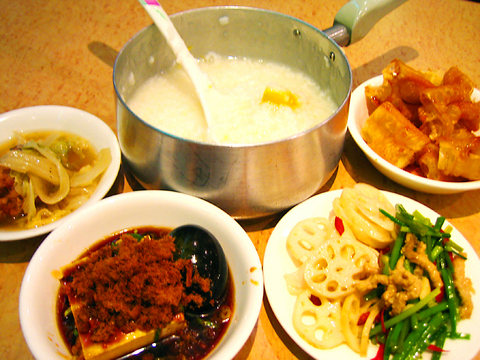Congee is a bland food. That's why it's a breakfast food in countries from Vietnam to Japan. But at the congee restaurants on Fuxing Road between Da'an and Technology Building MRT stations, it's a midnight snack.
Xiao Lizi is one of those restaurants with floor-to-ceiling windows revealing an ample buffet. A hostess stands outside telling passersby to stop for a snack. The place is less flashy but more popular than the others on either side and both floors fill up by 8pm, with customers streaming in and out into the wee hours of the morning. With a clean and simple decor, it's the perfect place to take a breather from your night on the town.
Congee can suffer from bad texture, which just compounds the problem of its blandness. But the congee you'll find at Xiao Lizi is a far cry from the leftover rice soaking in milky water that visits many a breakfast table in Taiwan. The ingredients are simple enough -- rice and water -- but a good consistency is difficult to attain with congee. If you cook it for too long, the rice grains disintegrate -- too short and the broth will be too watery. After cooking, the excess water can be drained to create a Western porridge-like consistency or left in to make it more like a soup. Xiao Lizi's congee is somewhere in between. Chunks of yam are thrown in to sweeten and thicken the mixture and the result is a pot of smooth, glowing goo.

PHOTO: MEREDITH DODGE, TAIPEI TIMES
The buffet table is the other option at Xiao Lizi. The first thing you must remember to put on your tray is a bowl of youtiao -- a stick of fried bread cut into sections to be soaked in the congee until it's tender and squishy.
Another typical congee side dish is thousand-year egg. One of the substances used to preserve the eggs (is it the charcoal or the lime?) reacts strangely with sweet flavors and if you take a bite of congee after a bite of the thousand-year egg without thoroughly rinsing your mouth, you will be greeted with a most unpleasant bitterness.
I found that, in general, the sweeter dishes went best with the congee, especially the deliciously crunchy lotus root and the tender leeks. If your stomach is up for it at that time of night, there are many other tempting dishes to try: stinky tofu, kung pao chicken, and several hearty stews. A selection of greens can be stir-fried or boiled to order.
If the thought of eating salty, fried dishes with sweet porridge turns you off, just ask for a pot of steamed rice instead.

On April 26, The Lancet published a letter from two doctors at Taichung-based China Medical University Hospital (CMUH) warning that “Taiwan’s Health Care System is on the Brink of Collapse.” The authors said that “Years of policy inaction and mismanagement of resources have led to the National Health Insurance system operating under unsustainable conditions.” The pushback was immediate. Errors in the paper were quickly identified and publicized, to discredit the authors (the hospital apologized). CNA reported that CMUH said the letter described Taiwan in 2021 as having 62 nurses per 10,000 people, when the correct number was 78 nurses per 10,000

As we live longer, our risk of cognitive impairment is increasing. How can we delay the onset of symptoms? Do we have to give up every indulgence or can small changes make a difference? We asked neurologists for tips on how to keep our brains healthy for life. TAKE CARE OF YOUR HEALTH “All of the sensible things that apply to bodily health apply to brain health,” says Suzanne O’Sullivan, a consultant in neurology at the National Hospital for Neurology and Neurosurgery in London, and the author of The Age of Diagnosis. “When you’re 20, you can get away with absolute

May 5 to May 11 What started out as friction between Taiwanese students at Taichung First High School and a Japanese head cook escalated dramatically over the first two weeks of May 1927. It began on April 30 when the cook’s wife knew that lotus starch used in that night’s dinner had rat feces in it, but failed to inform staff until the meal was already prepared. The students believed that her silence was intentional, and filed a complaint. The school’s Japanese administrators sided with the cook’s family, dismissing the students as troublemakers and clamping down on their freedoms — with

As Donald Trump’s executive order in March led to the shuttering of Voice of America (VOA) — the global broadcaster whose roots date back to the fight against Nazi propaganda — he quickly attracted support from figures not used to aligning themselves with any US administration. Trump had ordered the US Agency for Global Media, the federal agency that funds VOA and other groups promoting independent journalism overseas, to be “eliminated to the maximum extent consistent with applicable law.” The decision suddenly halted programming in 49 languages to more than 425 million people. In Moscow, Margarita Simonyan, the hardline editor-in-chief of the